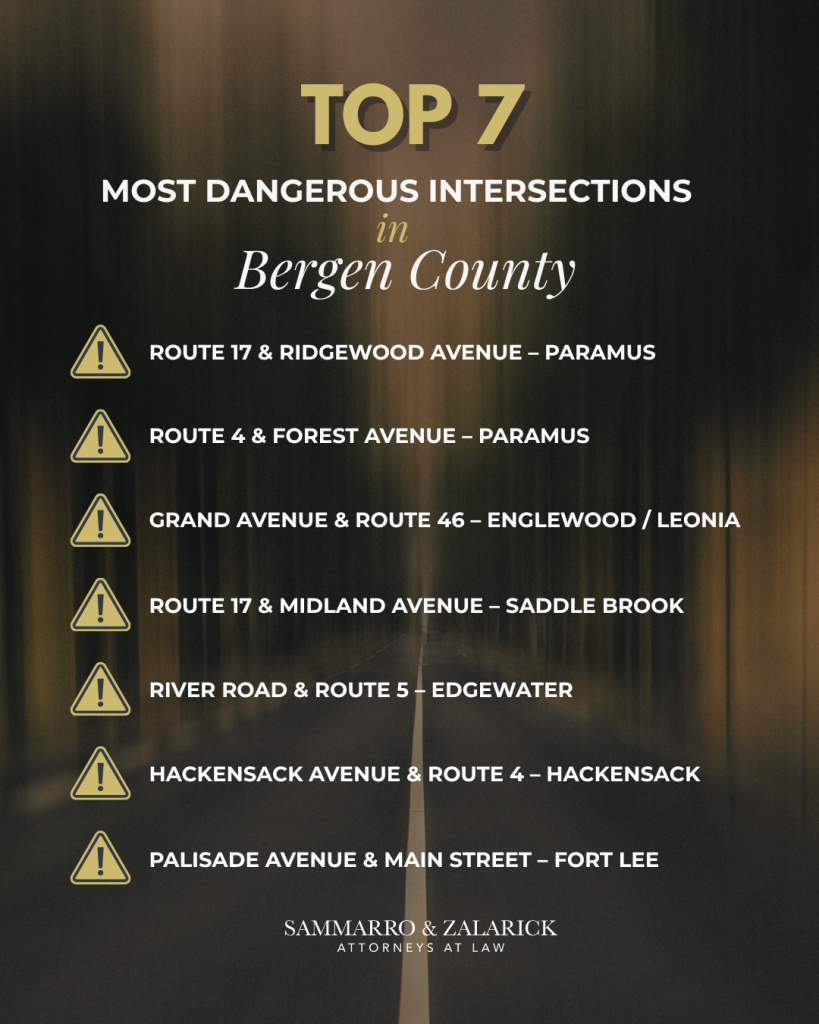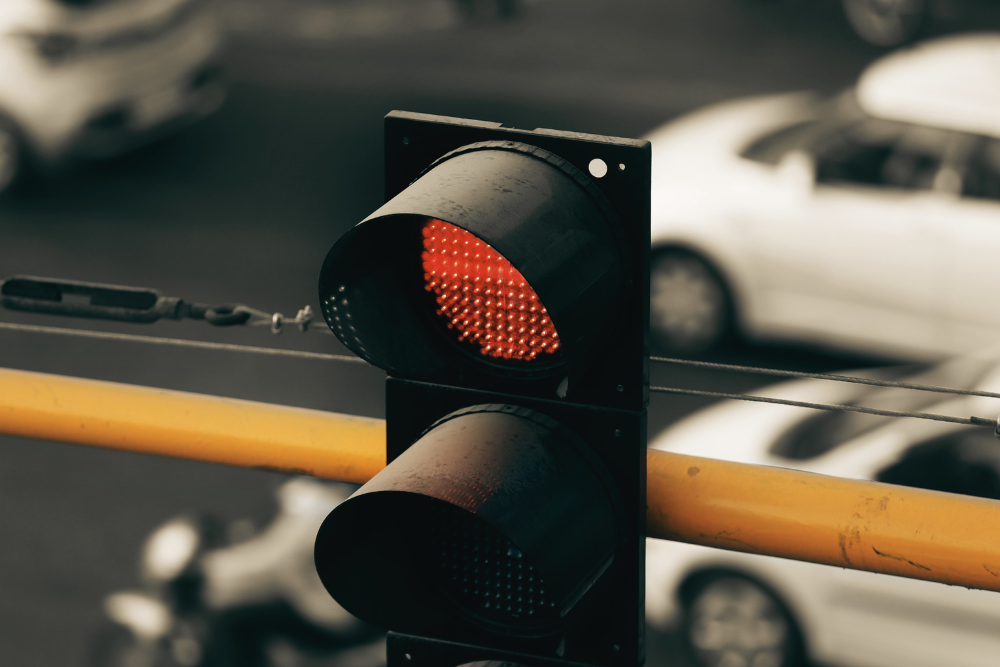Bergen County is known for its bustling suburbs, major shopping centers, and proximity to New York City. But with that convenience comes heavy vehicle and foot traffic—and a startling number of motor vehicle collisions. For drivers, cyclists, and pedestrians alike, certain intersections in Bergen County have become notorious for accidents.
This post highlights the most dangerous intersections in Bergen County, why these locations are so hazardous, what types of accidents commonly happen there, and most importantly—what legal steps you should take if you’re injured. Whether you were involved in a fender bender or a serious pedestrian crash, knowing your rights can make a major difference in your recovery and compensation.
Top 7 Most Dangerous Intersections in Bergen County, NJ
Crash data from the New Jersey Department of Transportation and local law enforcement consistently highlight several intersections in Bergen County as high-risk areas. These locations combine heavy traffic volume, tricky layouts, and frequent driver error.
1. Route 17 & Ridgewood Avenue – Paramus
This intersection sits at the heart of Paramus, one of the top retail hubs in the state. It serves as a connector for residents, out-of-town shoppers, and commercial delivery drivers. The constant inflow and outflow of vehicles near shopping centers like Garden State Plaza and Paramus Park Mall make it a hotspot for confusion and rear-end collisions.
Paramus police report dozens of crashes at this intersection annually—often involving distracted drivers trying to navigate multiple lanes while checking GPS or texting. Bad weather can also significantly reduce visibility and increase stopping distances.
2. Route 4 & Forest Avenue – Paramus
Route 4 is one of the most heavily trafficked roads in northern New Jersey. Forest Avenue intersects it near several commercial properties, with multiple access roads converging in a small stretch. Merging vehicles and limited signage often lead to T-bone collisions, especially when drivers are trying to make left turns across fast-moving traffic.
Injury victims here tend to suffer from whiplash, broken bones, or concussions due to the high-speed nature of crashes at this location.
3. Grand Avenue & Route 46 – Englewood / Leonia
This intersection becomes especially dangerous during commute hours as drivers approach the George Washington Bridge. When congestion builds, drivers often make aggressive lane changes or speed up to beat the light—resulting in side-swipe crashes and multi-car accidents.
This is also a common route for commercial vehicles, which adds another layer of risk for smaller passenger vehicles.
4. Route 17 & Midland Avenue – Saddle Brook
Heavy holiday shopping traffic, poor lane visibility, and unclear turning signals make this intersection hazardous—particularly during the winter months. Local residents have voiced concerns for years about the poorly timed traffic signals, which frequently lead to red-light running and near misses.
Even minor fender benders at this location can result in costly repairs and insurance disputes, making it a legal headache for injury victims.
5. River Road & Route 5 – Edgewater
Edgewater’s scenic location along the Hudson River attracts both commuters and pedestrians. But the area around River Road and Route 5 is a known pedestrian accident zone. Delivery trucks often block the shoulder, forcing pedestrians to walk dangerously close to traffic. At night, inadequate lighting further raises the risk of an accident.
Pedestrians struck in this area often face serious injuries such as broken hips, spinal injuries, or traumatic brain injuries, requiring months or years of recovery.
6. Hackensack Avenue & Route 4 – Hackensack
This intersection is located near The Shops at Riverside, a popular mall with frequent delivery traffic. It experiences constant congestion, especially on weekends. Drivers rushing to make turns into retail parking lots often underestimate oncoming traffic speeds.
The city has tried to improve flow with synchronized traffic lights, but accidents involving rideshare drivers and distracted motorists remain a serious issue here.
7. Palisade Avenue & Main Street – Fort Lee
This is one of the most densely packed intersections in Fort Lee, known for constant pedestrian and cyclist activity. With narrow lanes and frequent turning vehicles, it’s a common site for accidents involving bike riders, scooters, and people in crosswalks.
Even though Fort Lee has invested in street safety, enforcement remains challenging. Injured pedestrians here may have strong legal claims—especially if crosswalk rights were ignored.

Why These Intersections Are So Dangerous
Several factors contribute to the danger level of these Bergen County intersections:
High Vehicle Volume
With thousands of vehicles passing through daily, any lapse in driver attention or road design flaws can lead to serious accidents.
Mixed-Use Areas
Many of these intersections are near retail stores, schools, or hospitals, bringing in a mix of distracted drivers, elderly pedestrians, and aggressive delivery schedules.
Outdated Infrastructure
Some intersections still rely on outdated signage, poorly timed traffic lights, or unclear lane markings that confuse drivers unfamiliar with the area.
Weather Impact
Snow, rain, or even fog can turn these already dangerous roads into accident zones—especially when drivers fail to slow down or use headlights.
What to Do If You’re Injured in a Bergen County Intersection Accident
Taking the right steps after an accident isn’t just smart—it’s legally crucial. Here’s what to do:
1. Get Immediate Medical Attention
Even if you feel “fine,” symptoms of injuries like internal bleeding, whiplash, or concussions can show up hours or days later. Go to the nearest ER or urgent care, such as Hackensack University Medical Center or Englewood Health.
2. Preserve the Evidence
If you’re able, take photos of the scene, your injuries, vehicle damage, license plates, traffic signals, and nearby businesses with security cameras. This documentation can be invaluable later.
3. Get the Police Report
Always wait for law enforcement to arrive and ask for a report copy. If police are delayed, file a crash report yourself through the NJ MVC.
4. Don’t Talk to Insurance Companies Alone
Insurance adjusters often try to minimize payouts. A recorded statement given too soon can be used against you later. Always consult with a personal injury attorney in Bergen County before speaking to insurers.
5. Talk to a Personal Injury Lawyer Right Away
Consulting a lawyer early can help you:
- Understand your legal options
- Avoid common mistakes that harm your claim
- Calculate the true value of your damages
What Damages Can You Recover in a NJ Personal Injury Claim?
If you’re injured in a Bergen County car accident, you may be eligible to recover compensation for:
- Emergency medical costs
- Hospital stays and rehab
- Lost income or future earnings
- Vehicle repairs
- Emotional distress or PTSD
- Pain and suffering
A local attorney can help you gather the right evidence, build your claim, and negotiate with insurance companies to pursue maximum compensation.
How a Bergen County Personal Injury Lawyer Can Help
- Local Court Experience
- Your attorney will already be familiar with judges in Bergen County Superior Court, typical insurance company tactics, and how to prepare for New Jersey’s specific liability laws.
- Accident Reconstruction Expertise
- Your legal team may work with local experts who can examine skid marks, security footage, and black box data to determine who was truly at fault.
- Maximizing Settlement Value
- A seasoned attorney will negotiate strongly for a fair settlement—and take your case to trial if necessary.
Deadlines to File a Personal Injury Claim in New Jersey
New Jersey law gives you two years from the date of the accident to file a personal injury lawsuit. But don’t wait—evidence like surveillance footage and witness recollections fade fast.
If your accident involves a government vehicle or poorly maintained roadway, shorter deadlines may apply. An auto accident lawyer can help you act quickly.

